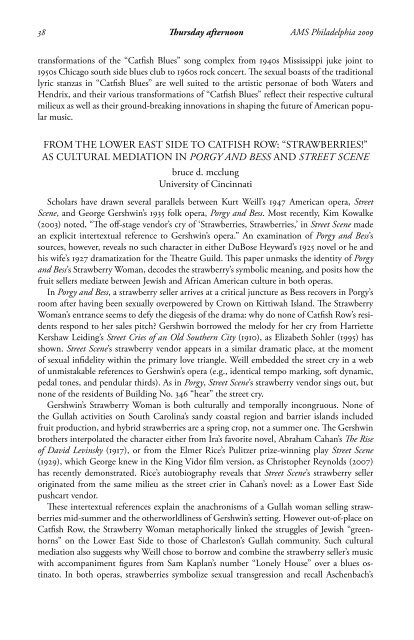AMS Philadelphia 2009 Abstracts - American Musicological Society
AMS Philadelphia 2009 Abstracts - American Musicological Society
AMS Philadelphia 2009 Abstracts - American Musicological Society
You also want an ePaper? Increase the reach of your titles
YUMPU automatically turns print PDFs into web optimized ePapers that Google loves.
38 Thursday afternoon <strong>AMS</strong> <strong>Philadelphia</strong> <strong>2009</strong><br />
transformations of the “Catfish Blues” song complex from 1940s Mississippi juke joint to<br />
1950s Chicago south side blues club to 1960s rock concert. The sexual boasts of the traditional<br />
lyric stanzas in “Catfish Blues” are well suited to the artistic personae of both Waters and<br />
Hendrix, and their various transformations of “Catfish Blues” reflect their respective cultural<br />
milieux as well as their ground-breaking innovations in shaping the future of <strong>American</strong> popular<br />
music.<br />
FROM THE LOWER EAST SIDE TO CATFISH ROW: “STRAWBERRIES!”<br />
AS CULTURAL MEDIATION IN Porgy ANd BeSS AND Street SCeNe<br />
bruce d. mcclung<br />
University of Cincinnati<br />
Scholars have drawn several parallels between Kurt Weill’s 1947 <strong>American</strong> opera, Street<br />
Scene, and George Gershwin’s 1935 folk opera, Porgy and Bess. Most recently, Kim Kowalke<br />
(2003) noted, “The off-stage vendor’s cry of ‘Strawberries, Strawberries,’ in Street Scene made<br />
an explicit intertextual reference to Gershwin’s opera.” An examination of Porgy and Bess’s<br />
sources, however, reveals no such character in either DuBose Heyward’s 1925 novel or he and<br />
his wife’s 1927 dramatization for the Theatre Guild. This paper unmasks the identity of Porgy<br />
and Bess’s Strawberry Woman, decodes the strawberry’s symbolic meaning, and posits how the<br />
fruit sellers mediate between Jewish and African <strong>American</strong> culture in both operas.<br />
In Porgy and Bess, a strawberry seller arrives at a critical juncture as Bess recovers in Porgy’s<br />
room after having been sexually overpowered by Crown on Kittiwah Island. The Strawberry<br />
Woman’s entrance seems to defy the diegesis of the drama: why do none of Catfish Row’s residents<br />
respond to her sales pitch? Gershwin borrowed the melody for her cry from Harriette<br />
Kershaw Leiding’s Street Cries of an old Southern City (1910), as Elizabeth Sohler (1995) has<br />
shown. Street Scene’s strawberry vendor appears in a similar dramatic place, at the moment<br />
of sexual infidelity within the primary love triangle. Weill embedded the street cry in a web<br />
of unmistakable references to Gershwin’s opera (e.g., identical tempo marking, soft dynamic,<br />
pedal tones, and pendular thirds). As in Porgy, Street Scene’s strawberry vendor sings out, but<br />
none of the residents of Building No. 346 “hear” the street cry.<br />
Gershwin’s Strawberry Woman is both culturally and temporally incongruous. None of<br />
the Gullah activities on South Carolina’s sandy coastal region and barrier islands included<br />
fruit production, and hybrid strawberries are a spring crop, not a summer one. The Gershwin<br />
brothers interpolated the character either from Ira’s favorite novel, Abraham Cahan’s The rise<br />
of david Levinsky (1917), or from the Elmer Rice’s Pulitzer prize-winning play Street Scene<br />
(1929), which George knew in the King Vidor film version, as Christopher Reynolds (2007)<br />
has recently demonstrated. Rice’s autobiography reveals that Street Scene’s strawberry seller<br />
originated from the same milieu as the street crier in Cahan’s novel: as a Lower East Side<br />
pushcart vendor.<br />
These intertextual references explain the anachronisms of a Gullah woman selling strawberries<br />
mid-summer and the otherworldliness of Gershwin’s setting. However out-of-place on<br />
Catfish Row, the Strawberry Woman metaphorically linked the struggles of Jewish “greenhorns”<br />
on the Lower East Side to those of Charleston’s Gullah community. Such cultural<br />
mediation also suggests why Weill chose to borrow and combine the strawberry seller’s music<br />
with accompaniment figures from Sam Kaplan’s number “Lonely House” over a blues ostinato.<br />
In both operas, strawberries symbolize sexual transgression and recall Aschenbach’s










